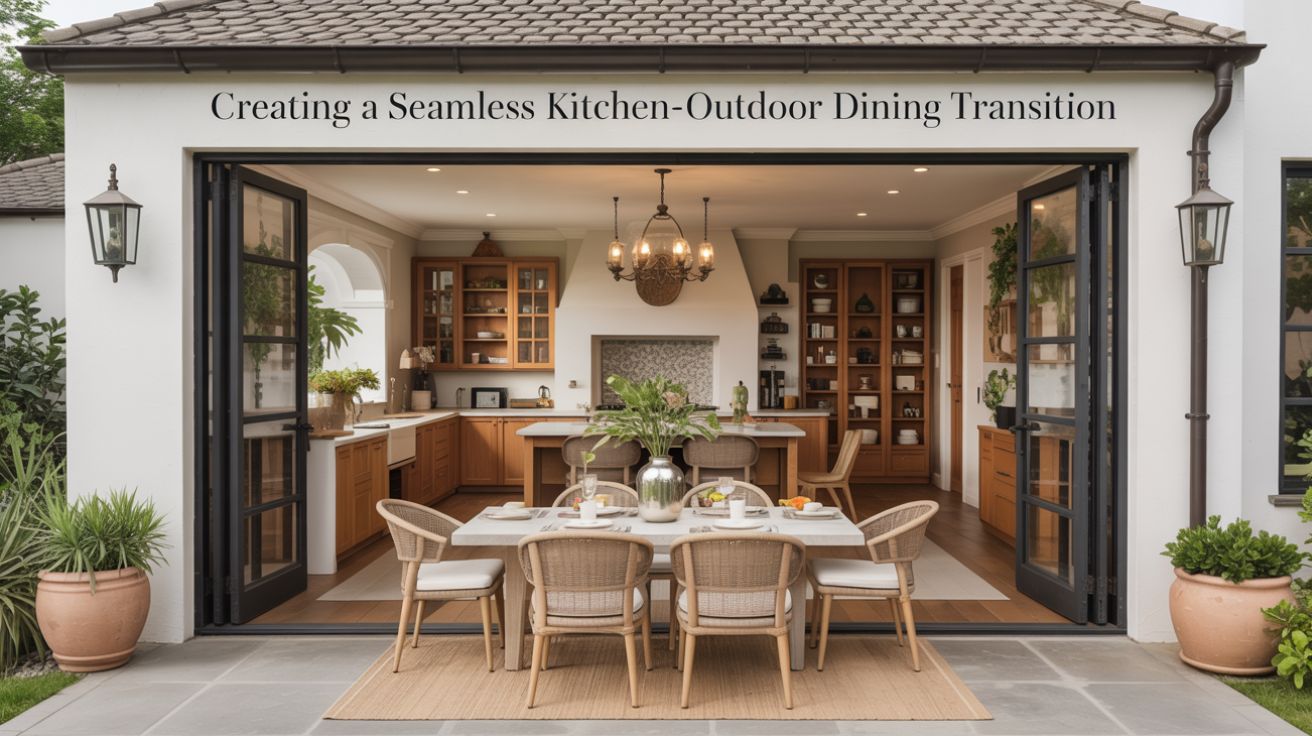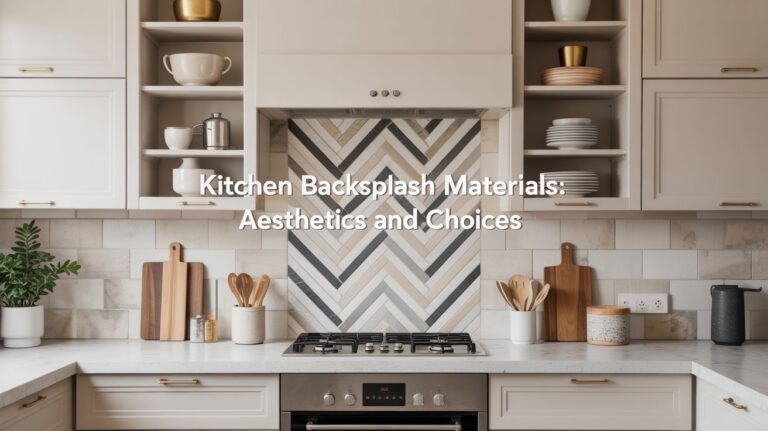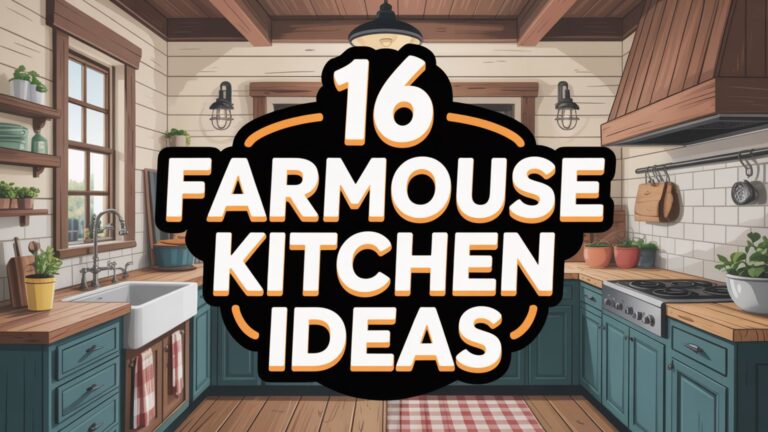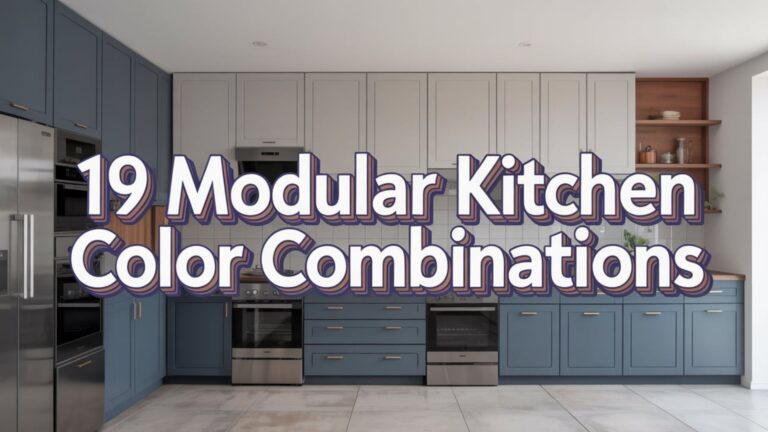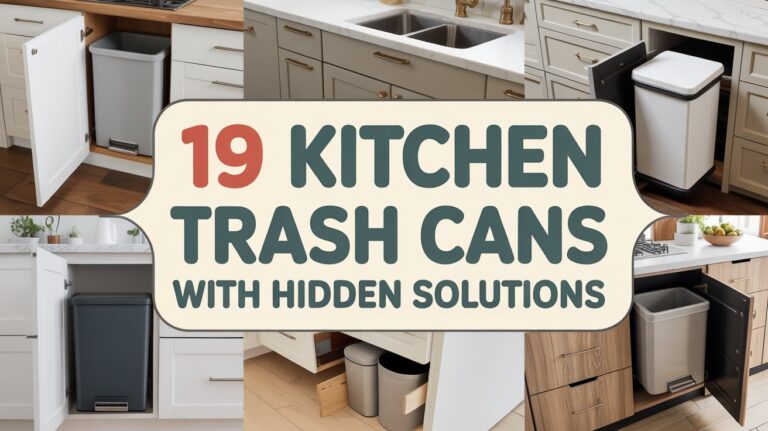How to Create a Seamless Transition From Kitchen to Outdoor Dining
I have been, or can be if you click on a link and make a purchase, compensated via a cash payment, gift, or something else of value for writing this post. As an Amazon Associate, I earn from qualifying purchases. Please read my full Affiliate Disclosure for more information.
To create a seamless kitchen-to-outdoor flow, align prep, grill, and dining zones so movement feels natural, with weatherproof surfaces that resemble indoor materials. Position utilities and storage close at hand, and use a contiguous circulation line to minimize backtracking. Layer lighting for ambience and function, and select durable, weather-ready furnishings that unify indoor and outdoor styles. Use privacy screens and thoughtful textures to frame the dining area without breaking sightlines. If you keep going, you’ll uncover more practical steps.
Key Takeaways
- Design a contiguous circulation line linking prep, grill, and plating to minimize steps between kitchen and outdoor dining.
- Use weatherproof, cohesive materials and textures that visually blend indoor and outdoor spaces.
- Position utilities, storage, and prep areas within arm’s reach of outdoor zones to reduce trips.
- Implement layered lighting (ambient, task, accent) and dimmable controls for mood and functionality.
- Incorporate privacy screens and thoughtful furniture layout to maintain sightlines while creating intimate dining areas.
Planning the Flow: Linking Indoor Kitchen Zones to Outdoor Dining Areas
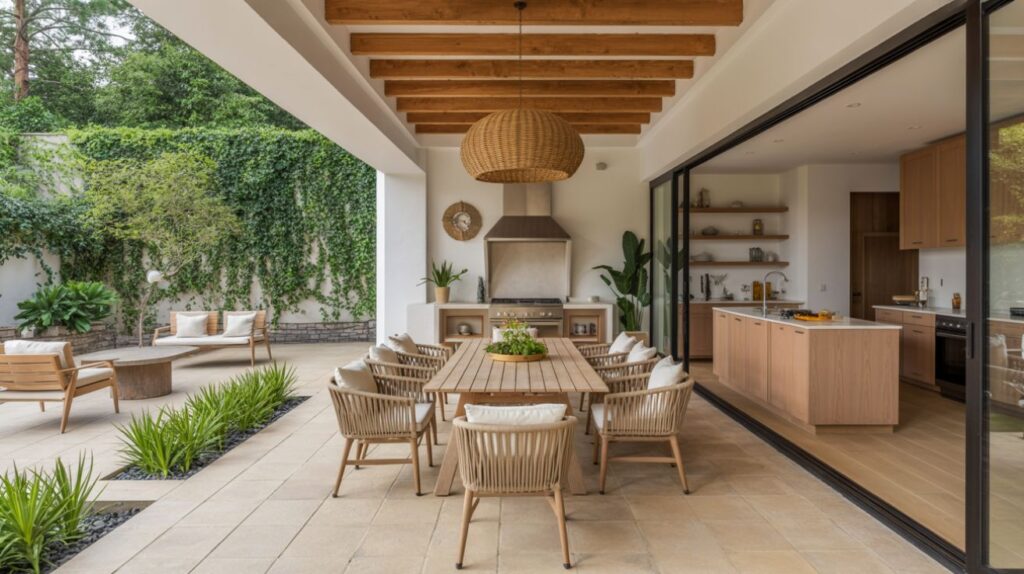
A seamless flow between your indoor kitchen and outdoor dining area starts with designing zones that work together, not in isolation. You’ll map how traffic moves, so prep stations, wash-up, and storage align with outdoor seating and cooking surfaces. Consider sightlines, lighting, and acoustics to keep conversations natural as you transition doors open. Designing outdoor seating should prioritize comfort and placement, guiding guests from the kitchen to the table without detours. Plan weatherproof textiles by selecting durable fabrics and coordinating colors that resist sun and rain. With intentional zoning, your space feels unified, efficient, and inviting for every meal.
Choosing Durable Surfaces That Stand Up to Weather and Scale
Choosing durable surfaces that stand up to weather and scale means prioritizing materials that resist sun, rain, and wear while still feeling cohesive with indoor textures. You want surfaces that endure daily use without cracking or fading, so select options with proven weatherproof finishes and low maintenance needs. Consider consistency with indoor palettes to preserve flow, yet allow outdoor-specific textures for grip and comfort. Selecting materials that perform under sun exposure and moisture reduces replacement cycles and supports long-term design integrity. Opt for weatherproof finishes, durable core materials, and practical installation details to keep progressions seamless and inviting. You’ll thank yourself later for thoughtful choices.
Aligning Appliances for Smooth Transitions Between Indoors and Outdoors
When you unite indoor and outdoor cooking and serving spaces, the right appliance alignment makes everything feel effortless. You’ll want a cohesive flow where tools and surfaces mirror indoor setups, but tolerate weather and heat. Prioritize proximity between prep, cook, and cleanup zones to minimize steps. Choose durable, weather‑savvy options and ensure proper ventilation and drainage. Consistent finishes and clear labeling boost usability, reducing misfires during service.
- Position components for a straight path between prep, cook, and serve areas
- Sync controls and power sources for appliances used outdoors
- Plan for weather‑proofing and easy maintenance within outdoor kitchen design
Layout Tweaks to Encourage Natural Movement From Prep to Plate
You’ll want a clear flow between prep and plating, so your movement stays smooth from cutting board to counter to table. Prioritize a natural path that keeps the prep area and the plate within easy reach, with a direct line from work zone to dining space. Consider how subtle tweaks to layout—like aligning the flow between zones and ensuring seamless access to the prep-plate passage—encourage you to move efficiently without thinking.
Flow Between Zones
Flow between zones starts with a clear, logical path that guides prep, cooking, and serving without forcing backtracking. You’ll design progressions that feel inevitable, not imposed, balancing proximity and safety while preserving yard beauty. Focus on sightlines, surface rhythms, and controlled traffic flow to maintain outdoor ambiance and landscape integration.
1) Create a single, contiguous circulation line that links prep, grill, and plating stations.
2) Use contrasting textures and edging to cue movement without crowding.
3) Place utilities and storage within arm’s reach of each zone, reducing trips.
Access to Prep-Plate Transition
Efficient access from prep to plate starts with a deliberate tweak to how the kitchen and dining zones meet. You’ll prioritize a clear, logical path that minimizes detours and backtracking. Position the outdoor prep area adjacent to hot stations, with a short, level progression from prep to plate. Use marked edges, low shelves, and compact staging so items flow without interruption. Minimize door flicks or thresholds; keep a straight sightline to service points. Mount portable prep surfaces near the dining zone for quick transfers. With these tweaks, prep plate transition becomes natural, efficient, and easier to trust daily.
Lighting Your Outdoor Space for Conversational, All-Weather Dining
As you design lighting for an all-weather, conversational outdoor dining setup, start with a layered approach that balances function and mood. You’ll use ambient lighting to set softness, task lighting for prep near changeover, and strategic accents to highlight decor. This combination keeps conversations comfortable without glare, while weatherproof fixtures guarantee reliability. Decorative accents add personality without clutter, completing the scene.
- Install dimmable outdoor-ready fixtures for flexible mood shifts.
- Use warm, color-consistent bulbs to preserve a natural conversation tone.
- Incorporate subtle, weatherproof decorative accents that reinforce the kitchen-to-dining connection.
Weather-Resistant Furnishings That Look Like Part of the Kitchen
Weather-resistant furnishings that blend with your kitchen vibe aren’t an afterthought; they’re the bridge between indoor prep and outdoor dining. You want pieces that endure sun and rain while feeling cohesive with your countertop and cabinets. Choose weatherproof textiles for cushions and accents, so you don’t retreat at every sprinkle. Look for UV resistant finishes on tables and chairs to prevent fading and chalky coating. Materials that mirror metal, stone, or wood tones keep the kitchen feel consistent, even outside. Prioritize easy-clean surfaces and modular options that reconfigure for gatherings, so the transition stays seamless, practical, and stylish.
Storage Solutions That Keep Essentials Close at Hand
Think of compact cabinet ideas and a near-access pantry as your first line of defense against kitchen-to-dining chaos. You’ll want zones that keep essentials visible, organized, and within arm’s reach for quick prep and service. Start with smartly sized storage that fits outdoor use, so you can grab what you need without a hunt.
Compact Cabi Ng Tips
When you’re outfitting a kitchen that doubles for outdoor dining, compact cabinet ideas keep essentials within easy reach without clutter. You’ll maximize cabinet organization and space optimization by choosing shallow pullouts, labeled bins, and vertical dividers that fit between shelves.
- Use pullout spice racks and small pantry baskets to keep timers, skewers, and napkins accessible
- Install slim, adjustable organizers for lids, cutting boards, and trays to reduce search time
- Add magnetic strips and hooks inside doors for utensils, measuring spoons, and lightweight tools
These tweaks maintain flow while preserving a tidy, functional outdoor-dining setup.
Near-Access Pantry Gear
Near-Access Pantry Gear takes the same mindset you used for compact cabinets and applies it to the pantry itself, so you can grab what you need without a shelf-stewed search. You’ll optimize layout for flow, grouping staples by frequency and purpose. Use pull-out racks, labeled bins, and clear fronts to boost pantry organization, making seconds count rather than seconds wasted. Keep essentials at eye level and within reach, then rotate stock to avoid redundant buys. This approach increases storage accessibility, minimizes digging, and simplifies meal prep, ensuring outdoor dining setups stay streamlined and enjoyable.
Cozy Details That Invite Guests to Shift From Cooking to Dining
Cozy details do more than decorate a space—they cue guests to settle in and shift from cooking mode to dining mode. You create this shift with tactile cues and thoughtful setup that whisper “stay awhile.” Focus on warmth, containment, and flow, so conversations flourish without clutter.
1) Use a fire pit as a subtle centerpiece, drawing people outward without overpowering the kitchen space.
2) Add privacy screens that frame the dining zone, offering intimacy while preserving sightlines to the grill.
3) Bring in soft textures—throw blankets, cushions, and low lighting—to invite relaxed, lingered meals and easy conversation.
Practical Tips for Seasonal Transitions and Maintenance
Outdoor spaces ask for a practical approach as the seasons shift, especially after you’ve set up warm, inviting details. Start with a simple maintenance routine: inspect furniture and lighting, test electrical outlets, and clean grilling gear after each use. Store cushions in breathable bins to prevent mildew, and rotate seasonal decor to reflect the current weather without clutter. Plan a lightweight progression: add wind shields, weatherproof covers, and easy-access storage for quick changes. For pest control, seal gaps, remove standing water, and batten down entry points before the next season. Consistency saves effort and preserves comfort year round.
Conclusion
You can choreograph a seamless flow by treating indoors and outdoors as one space. Align prep zones with outdoor stations, choose durable surfaces, and tuck appliances where movement feels effortless. Use lighting that invites lingering, weather-resistant furnishings that read as part of the kitchen, and smart storage so essentials stay at hand. Add cozy details to ease progression, and plan seasonal maintenance so the vibe endures year-round. With thoughtful tweaks, dining outdoors becomes a natural extension of cooking.
